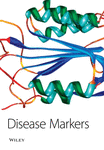MMP-9, Homocysteine and CRP Circulating Levels Are Associated with Intraluminal Thrombus Thickness of Abdominal Aortic Aneurysms–New Implication of the Old Biomarkers
Abstract
Background: Abdominal aortic aneurysms (AAAs) are characterized by presence of high proteolytic activity, atherosclerotic lesions, extensive transmural inflammation and the presence of variably sized and shaped intraluminal thrombus (ILT). Therefore, we evaluated a possible association between plasma matrix metalloproteinase-9 (MMP-9), homocysteine (Hcy), high-sensitivity C-reactive protein (hsCRP) levels and ILT thickness in patients with AAA.
Methods: Plasma concentrations of MMP-9, Hcy and hsCRP were determined and ILT thickness was measured in 71 patients with AAA. They were divided into 2 groups according to ILT thickness: 34 patients with ILT mean thickness ≥ 9 mm and 37 patients with ILT < 9 mm.
Results: Plasma MMP-9 and CRP concentrations in patients with thin ILT were significantly higher than in group with thick ILT (medians 610 vs. 485 ng/mL, p = 0.00003, and 7.7 vs. 3.3 mg/L, p < 0.00001, respectively) In contrast, plasma Hcy concentrations in patients with thin ILT were significantly lower than in the group with thick ILT (medians 14.3 vs. 19.2 μmol/L, p < 0.00001). Multiple regression models adjusted for age and AAA diameter showed that thin ILT is an independent predictor of high MMP-9 and CRP concentrations, while thick ILT predicts high Hcy concentrations.
Conclusions: Association of higher plasma levels of MMP-9 and CRP with thin ILT may be related to two phenomena: thin thrombi convey more elastolysis-stimulating factors from blood to the AAA wall and thin thrombi convey more factors involved in proteolysis and inflammation from AAA wall to blood. The association of thin ILT with lower plasma Hcy concentrations may be related to the role of Hcy as a prothrombotic marker and needs further research.




